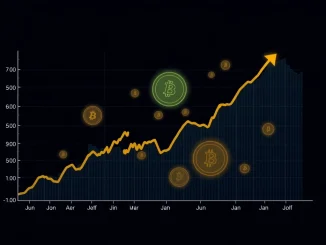
Hold onto your hats, folks! The U.S. stock market is experiencing a wild ride today. Investors are witnessing a significant downturn as the Nasdaq crash leads the charge in a broad market sell-off. If you’re tracking the markets, you’ve likely seen the red flashing across your screens. Let’s dive into what’s happening and what it could mean.
What Triggered This Stock Market Plunge?
During today’s trading session, the Nasdaq Composite index took a nosedive, falling by a staggering 5.14% intraday. This isn’t just a minor dip; it’s a significant stock market plunge that has sent ripples of concern throughout the financial world. But the Nasdaq isn’t alone in this sea of red. The S&P 500 index is also feeling the heat, currently down by 5.09%, and the Dow Jones Industrial Average isn’t far behind, registering a 4.51% decrease.
Here’s a quick snapshot of the declines:
| Index | Intraday Decline |
|---|---|
| Nasdaq Composite | 5.14% |
| S&P 500 | 5.09% |
| Dow Jones Industrial Average | 4.51% |
While the exact catalysts for such a sharp market correction are always multifaceted and debated, several factors could be contributing to this sudden downturn. These could include:
- Economic Data Concerns: Recent economic data releases might be painting a less optimistic picture of future growth, leading investors to reassess their positions.
- Inflation Fears: Persistent inflation and the potential for further interest rate hikes by the Federal Reserve often spook the markets.
- Geopolitical Uncertainty: Global events and geopolitical tensions can always inject volatility and uncertainty into the market.
- Profit Taking: After a period of gains, some investors may be locking in profits, contributing to selling pressure.
Is This Just a Market Correction or Something More Serious?
The million-dollar question on everyone’s mind is whether this market correction is a temporary blip or a sign of a deeper, more prolonged downturn. A market correction is generally defined as a 10% to 20% drop from a recent high. While today’s declines are significant, they are still within the realm of a severe correction, rather than a full-blown market crash (typically considered a 20% or greater decline).
However, the speed and breadth of today’s sell-off are certainly raising eyebrows. A Dow Jones fall of over 4% is not an everyday occurrence, and when coupled with similar drops in the Nasdaq and S&P 500 decline, it signals widespread investor anxiety.
What Does a Dow Jones Fall and S&P 500 Decline Mean for You?
For everyday investors, a day like today can be unsettling. Seeing your portfolio values decrease rapidly can trigger emotional responses. It’s crucial to remember a few key points during times of market volatility:
- Don’t Panic Sell: Historically, panic selling during market downturns is often detrimental to long-term investment goals. Try to avoid making emotionally driven decisions.
- Review Your Portfolio: Assess your portfolio’s diversification and risk tolerance. Is your asset allocation still aligned with your long-term objectives?
- Consider the Long Term: Market corrections are a normal part of the investment cycle. Focus on your long-term investment strategy rather than short-term fluctuations.
- Seek Professional Advice: If you are unsure about how to navigate market volatility, consult with a qualified financial advisor.
Navigating the Nasdaq Crash and Market Uncertainty
While no one can predict the future with certainty, understanding the dynamics of market corrections and potential market crashes is vital. Today’s Nasdaq crash and broader stock market plunge serve as a reminder of the inherent risks in investing.
Here are a few actionable insights to consider:
- Stay Informed: Keep abreast of market news and economic developments, but avoid being glued to minute-by-minute market movements.
- Diversification is Key: A well-diversified portfolio across different asset classes can help mitigate risk during market downturns.
- Dollar-Cost Averaging: For long-term investors, market corrections can present opportunities to buy assets at lower prices through dollar-cost averaging.
- Maintain a Long-Term Perspective: Focus on your long-term financial goals and avoid making rash decisions based on short-term market noise.
In Conclusion: Weathering the Stock Market Plunge
Today’s stock market plunge, led by a significant Nasdaq crash, is undoubtedly a noteworthy event. While the reasons are complex and multifaceted, and the future market trajectory remains uncertain, it’s essential for investors to remain calm, informed, and focused on their long-term investment strategies. Remember, market corrections are a natural part of the economic cycle, and while they can be unsettling, they also present opportunities for long-term growth. Stay resilient, stay informed, and navigate these volatile times with a clear and rational approach.



